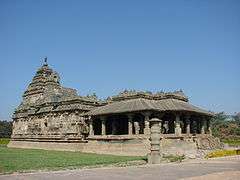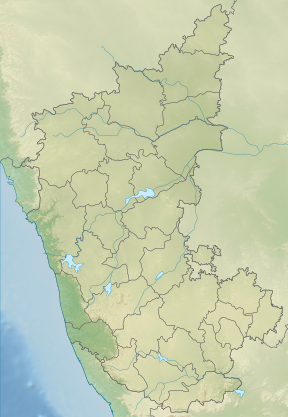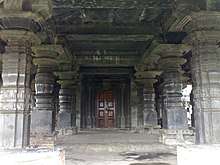Jain Temple, Lakkundi
The Jain Temple, Lakkundi or Brahma Jinalaya is located in the historically important temple town Lakkundi in the Gadag District of Karnataka state, India.
| Jain Temple, Lakkundi | |
|---|---|
 Brahma Jinalaya | |
| Religion | |
| Affiliation | Jainism |
| Deity | Mahavira |
| Festivals | Mahavir Jayanti |
| Location | |
| Location | Lakkundi, Karnataka |
 Location within Karnataka  Jain Temple, Lakkundi (India) | |
| Geographic coordinates | 15°23′22.2″N 75°42′51.2″E |
| Architecture | |
| Creator | Kalyani Chalukyas |
| Date established | mid-11th century |
| Temple(s) | 1 |
Archaeological Survey of India has listed this basadi in the complex in the list of "Must See" Indian Heritage.[1]
History
The town of Lakkundi was known as Lokkigundi in medieval times, the town was of considerable importance during the 11-12th century A.D. Western Chalukya rule. The Brahma Jinalaya built by Attimabbe, wife of Nagadeva, who served as general under both Taila II and Satyashraya Irivabedanga (997-1008 A.D.). Satyasraya Irivabedanga had the title ‘Sarvavarnadharmadhanu’ – meaning bow that respects all religions, without discrimination.[2] The temple represents the second phase of Kalyani Chalukyas art.[3] It is said that Attimabbe donated 1,500 jewel-studded statues of thirthankaras and 1,000 copies of the manuscript of Ponna’s ‘Santipurana’ written on palm-leaves book.[4][5] With the waning of their power, in 1191 A.D., the noted Hoysala empire king Veera Ballala II made this town an important garrison.[6]
In 12th century, Chaturmukh Bharma was installed by villagers giving the temple the name Brahma Jinalaya. Historical records note that there were 5 Jain temples in the region but only this temple survives.[7]
Architecture

According to the art historian Adam Hardy, the architectural style of the temple can be classified as "Later Chalukya style, mainstream Lakkundi school of mid-11th century with late 11th century superstructure (shikhara)". The temple has single shrine (ekakuta vimana) connected to a closed mantapa hall via a vestibule (sukanasi or ardhamantapa) that is connected to another, open mantapa.[8] This temple is famous for its architecture and considered one of the finest example of Western Chalukya architecture.[9][10][11] The temple has a garbhagriha, an antarala and a closed navaranga, and an open pillared mandapa. Over the garbhagriha is raised a five storeyed nirandhara vimana with a square griva and sikhara. Above the cornice of these arched niches at regular intervals is a seated Jaina figure. The cellings are plain and pillers are well decorated. The open mandapa is supported by 32 pillars and pilasters.[1]
According to art critic Percy Brown, these units are found commonly in all Western Chalukya temples. The building material is soapstone, which according to Percy Brown became the standard in later Hoysala architecture as well.[12][13] According to art historians Henry Cousens and Om Prakash, the most conspicuous feature of the Western Chalukya temples is the decrease in the size of masonry and the resulting decrease in the overall height of the temples compared to those built by the Badami Chalukyas at Pattadakal. This was a result of a shift in the basic building material, from sandstone to the more workable soapstone (Chloritic Shist). In the coming decades, this transformation was to lead Vesara architecture toward increased ornamentation and articulation.[6][9]
Cousens categorizes the tower over the shrine as Dravidian (south Indian) but historian Kamath feels it is more Vesara because each tier are encrusted with motifs that make the tower more "curvilinear".[14] According to Cousens, the overall structure with its well proportioned tiers and finial (amalaka, kalasha) give the superstructure a "majestic" look. Above the cornice are circular niches, each of which holds the image of a Jain saint (Jaina) in relief, with a kirtimukha decoration above. The walls of the shrine have pilasters, with the spaces between them containing, in relief, pavilions, and miniature decorative towers (aedicula) on slender half pilasters. Some miniature towers have niches below them. Overall, the decorative ornamentation is taken to a new level compared to earlier temples.[15]
Sculpture
There are three notable freestanding sculptures in the temple. An image of Mahavira that is a little over 4 feet tall, made of black polished stone and seated on a "lion throne" (simhaasana) is found outside the temple. Originally this idol was housed as original mulnayak of temple.[1] Neminatha is the mulnayak of the temple placed in the inner sanctum of the temple with yaksha and yakshi on either side.[7] There is a beautiful sculpture of seven hooded Parshva in Kayotsarga position with yakshi and yaksha on both sides.[16] The sculpture of Padmavati[3] sitting with left knee upright besides Parshva depicts Goddess with goad and noose in right and left upper arms respectively and the lower hands are in varadamudra with fruit.[17]
Cousens feels it may have been taken out and left there. The saint has an attendant on either side, holding a chowri (a type of brush) in one hand a fruit in another. An exceptionally well rendered image of the God Brahma[3] stands in the inner hall, and that of the goddess Saraswati stands at the entrance to the vestibule. In each of her four hands she holds an attribute; a ankusa (elephant goad), a petaled flower, a book and a citron. In addition to these sculptures, the relief of a Jaina is carved on to the door lintel of the sanctum and outer hall, and an image of Gajalakshmi (Lakshmi with elephants on either side) exists over entrance to the vestibule.[18]
Lakkundi Utsav
Lakkundi Utsav is two-day annual cultural event organised annually. The event has main stage with temples as the background, is named 'Daana Chintamani Attimabbe Vedike' after 11th century queen Attimabbe.[19]
Protection
The temple is protected as a monument of national importance by the Archaeological Survey of India.[20] Karnataka government has announced setting up Lakkundi Development Authority for the development of Lakkundi at cost of Rs. 3 crores.[21] More than 50 sculpture and 3 inscriptions were discovered in 2018, these sculpture are conserved by ASI.[22]
See also
| Wikimedia Commons has media related to Jain Temple, Lakkundi. |
- Shantinatha Basadi, Jinanathapura
- Akkana Basadi, Shravanabelagola
References
Citations
- ASI must see & Jain Basti, Lakkundi.
- The Hindu & Speaks of catholic outlook.
- Chugh 2016, p. 305.
- Deccan Herald & Luminous Lakkundi.
- Deccan Herald & Marvels of Lakkundi.
- Cousens 1926, p. 77.
- Outlook & Lakkundi.
- Hardy 1995, p. 173.
- Prakash 2005, p. 178.
- Sangave 1980, p. 371.
- Jain 2009, p. 242.
- Hardy 1995, p. 335.
- Kamath 1980, pp. 115-117.
- Kamath 1980, p. 117.
- Cousens 1926, p. 78.
- Shah 1987, p. 185.
- Shah 1987, p. 270.
- Cousens 1926, pp. 78-79.
- The Hindu & Lakkundi Utsav.
- ASI & List of Protected Monuments - Dharwad Circle.
- Deccan Herald & Lakkundi Development Authority.
- The New Indian Express & 11th-century Chalukya era sculptures.
Sources
- Chugh, Lalit (2016), Karnataka's Rich Heritage - Art and Architecture: From Prehistoric Times to the Hoysala Period, 6, Notion Press, ISBN 9789352068258
- Cousens, Henry (1996) [1926]. The Chalukyan Architecture of Kanarese Districts. New Delhi: Archaeological Survey of India. OCLC 37526233. Archived from the original on 31 March 2010.
- Foekema, Gerard (2003) [2003]. Architecture decorated with architecture: Later medieval temples of Karnataka, 1000–1300 AD (PDF). New Delhi: Munshiram Manoharlal Publishers Pvt. Ltd. ISBN 81-215-1089-9.
- Jain, Arun Kumar (2009), Faith & Philosophy of Jainism, 6, Gyan Publishing House, ISBN 9788178357232
- Kamath, Suryanath U. (2001) [1980]. A concise history of Karnataka: from pre-historic times to the present (PDF). Bangalore: Jupiter books. LCCN 80905179. OCLC 7796041.
- Hardy, Adam (1995), Indian Temple Architecture: Form and Transformation : the Karṇāṭa Drāviḍa Tradition, 7th to 13th Centuries, Abhinav Publications, ISBN 9788170173120
- Sangave, Vilas Adinath (1980), Jaina Community: A Social Survey, 2, Popular Prakashan, ISBN 9780317123463
- Shah, Umakant Premanand (1987), Jaina-rūpa-maṇḍana, 1, Abhinav Publications, ISBN 9788170172086
- Prakash, Om (2005), Cultural History Of India, New Age International, 2005, New Delhi, New Age International, ISBN 81-224-1587-3
- "Alphabetical List of Monuments - Karnataka - Dharwad, Dharwad Circle, Karnataka". Archaeological Survey of India, Government of India. Indira Gandhi National Center for the Arts. Retrieved 8 April 2013.
- "Jain Basti, Lakkundi, Karnataka". Archaeological Survey of India.
- "Marvels of Lakkundi". Deccan Herald. 7 May 2012.
- "Luminous Lakkundi". Deccan Herald. 21 December 2019.
- "Lakkundi Development Authority to be set up at a cost Rs 3 crore". Deccan Herald. 16 March 2017.
- "11th-century Chalukya era sculptures found in Gadag district". The New Indian Express. 26 December 2018.
- "You've Heard Of Hampi, But Have You Heard Of This Gem Nearby?". Outlook (Indian magazine). 26 December 2018.
- "Village of hundreds of wells, temples ready for Lakkundi Utsav". The Hindu. 11 February 2017.
- "Speaks of catholic outlook". The Hindu. 11 May 2013.

_Brahma_image_in_the_mantapa_in_the_Jain_temple_at_Lakkundi.jpg)
